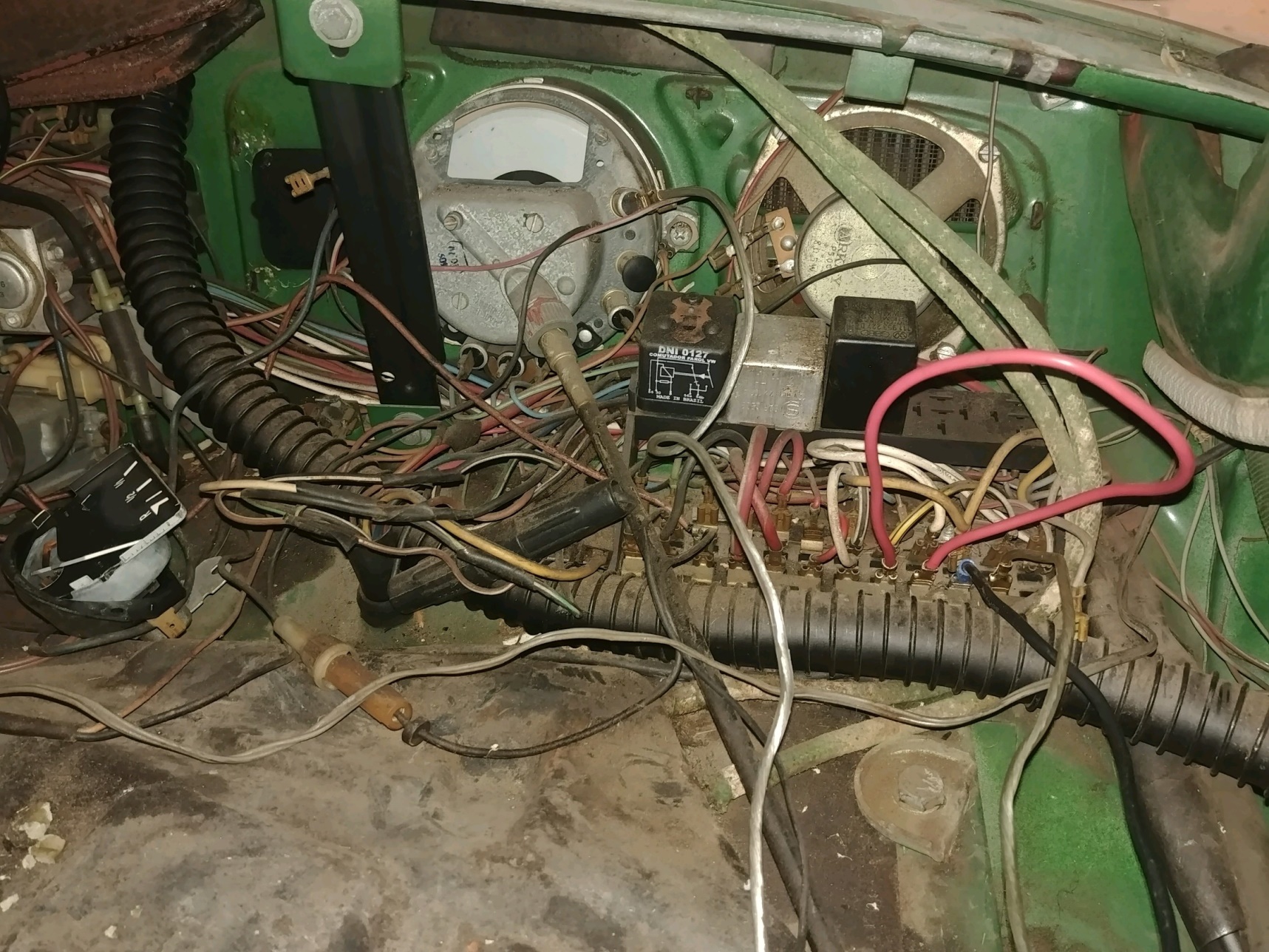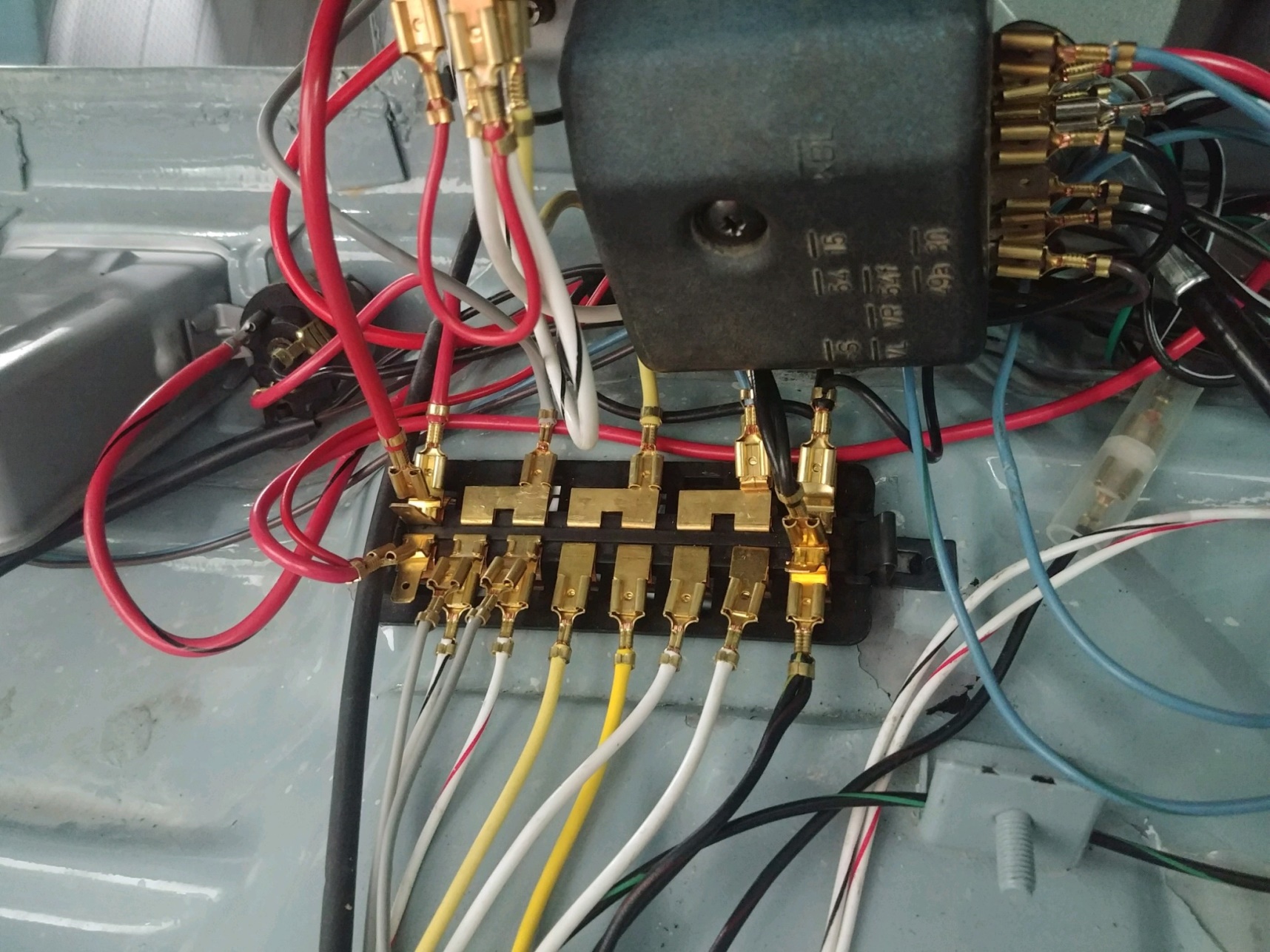One of the most feared and often neglected portions of Vintage VWs is the electrical system. As long as the basic systems in the car- the charging system and the lights- work, most people are content. Unfortunately, this means that often times there are wires cut, spliced and loose throughout the car. After years of working on vintage VWs, I have found that many electrical problems can be attributed to the original, old, dry and brittle wiring being modified and added on to by who knows how many people in the past. Lights being dim or not working, the wipers not working, batteries dying, or odd things like the radio turning off when the headlights are turned on are more often than not caused by problems with the all the modifications to the original wiring over time.

This isn’t an article on how to completely re-wire your car, it is an introduction to some of the basics of VW wiring and a guide explaining what all those wires in your VW are doing and what those numbers on the switches and relays mean. VW wiring typically follows a few guidelines:
• Red Wires (including wires with tracers) are Battery Power
• Black Wires (including wires with tracers) are Ignition Switch Power
• White, Yellow and Grey Wires (including wires with tracers) are for the Lights
• Blue Wires (including wires with tracers) are for Indicators (turn, oil, high beam, and flasher)
• Brown Wires (including wires with tracers) are for Grounds
Knowing that, if you take a look at the VW wires attached to an 8 terminal (used in 1961 through 1966 models) fuse box, you’ll typically see red wires on one side, a pair of fuses with white wires, a pair of fuses with yellow wires, a pair of fuses with grey, white-black, white-red wires, and a fuse with black wires. The terminal at one side is battery power, the terminal at the other is ignition power, and the 6 terminals in between are all for the headlights and running lights. Later models add more key and ignition power fuses, 1 more at each side for the 10 terminal box and 2 more at each side for the 12 terminal fuse box.

One major thing to note is that the power to the front of the car, the main red power cable, pictured above on the left side of the fuse box, is not fused. It runs from the battery or voltage regulator, all the way to the headlight switch, and from the headlight switch to the ignition switch and fuse block. Additionally, the ignition power to the coil, from the ignition switch, is not fused. That means that two of the most important wires to your VW running do not have a fuse. We highly recommend running a manually re-settable circuit breaker or a heavy duty main fuse on the main power wire as a safety measure.
We’ve put together a list of most every electrical terminal and color wire used by VW in all models up to 1974. We don’t get into the fuel injection wiring which is used as early as 1968 in Type 3s, but even the rest of the wiring in the 1968 and later Type 3s still follows the below information. VW added more colors as the years progressed but the same basic information usually applies.
Wire Description |
Typical Wire Color/s |
|
| Ignition Switch | ||
| 15 / 54 | + Ignition Switched Power from Ignition Switch | Black |
| 30 | + Battery Power from Fuse Box / Headlight Switch (NOT FUSED) | Red |
| P | + Accessory Position Power (not typically used) | Grey |
| X | + Ignition On Power to Headlight Switch | Black-Yellow / Red-Black |
| S | - Key In Ground (for ignition-door buzzer, not typically used) | Brown |
| Starter | ||
| 50 | + Starter Solenoid Power from Ignition Switch | Red / Red-Black |
| B+ | + Power from Battery Cable | Black or Red |
| Engine, Battery, Alternator/Generator & Voltage Regulator | ||
| 1 | Condenser Hook Up from the Distributor | Green |
| 15 | + Ignition Switched Power from Ignition Switch (NOT FUSED) |
Black |
| Carburetor Choke and Solenoid (from 15 on coil - NOT FUSED) |
Black | |
| 61 | Generator/Alternator Charge Indicator | Blue |
| B+ | + Battery Positive Terminal | Black / Red |
| B- | - Battery Negative Terminal | Braided Metal Strap / Black |
| D+ | Generator Terminal to Voltage Regulator | Red |
| DF | Generator Field Terminal to Voltage Regulator | Green |
| Oil Pressure Switch to Indicator Bulb in Speedometer | Green-Blue | |
| Turn Signal Switch | ||
| 31 | - Ground | Brown |
| 49a / L | + Output from Flasher Relay or Flasher Switch | Black-White-Green |
| 54 | + Input from Brake Light Switch | Black-Red |
| 54F | + Output to Rear Brake Lights | Black-Purple |
| -S / S- | Switched Ground Signal to Horn | Brown |
| S | Switched Ground Signal to Headlight Relay | Brown-White |
| L / VL | + Left Turn Signal | Black-White |
| R / VR | + Right Turn Signal | Black-Green |
| Emergency Flasher Relay & Switch | ||
| 15 | + Ignition Switched Power from Fuse Box | Black |
| 30 | + Battery Power from Fuse Box | Red |
| 31 | - Ground | Brown |
| 49 / X | + Input from Fuse Box or Flasher Switch | Black-White-Green / Blue |
| 49a / L | + Output from Flasher Relay or Flasher Switch | Black-White-Green |
| 54 | + Input from Brake Light Switch | Black-Red |
| 54F | + Output to Rear Brake Lights | Black-Purple |
| K / KBL / B1 | Switched Signal Indicator | Blue |
| S / -S | Switched Ground Signal | Brown |
| L / VL | + Left Turn Signal | Black-White |
| R / VR | + Right Turn Signal | Black-Green |
| Wiper Motor & Switch | ||
| 30 | + Ignition Switched Power from Fuse Box | Black |
| 31 | - Ground | Brown |
| 31b | - Switched Ground | Brown |
| 53 / 54d | + Wiper Motor Speed 1 | Black |
| 53a / 54 | + Wiper Self Park | Black-Purple |
| 53b | + Wiper Motor Speed 2 | Black-Yellow |
| 53e | Wiper (Brake Winding - Self Park) | Green |
| Headlights, Running & Parking Lights & Switches | ||
| 30 | + Power from Battery or Voltage Regulator (NOT FUSED) | Red |
| 31 | - Ground | Brown |
| 56 | + Head Light Power | White-Black |
| 56a | + High Beams | White |
| + High Beam Indicator | Blue-White | |
| 56b | + Low Beams | Yellow |
| 57 / 57L / 57R | + Front Parking Lights (L - Left, R - Right) (NOT FUSED) (We usually use the 58 terminal instead of the 57 Terminal for the front parking lights as it is fused) |
Grey |
| 58 / 58L / 58R | + Sidemarker, Tail, & License Plate Lights (L - Left, R - Right) | Grey / White-Black / White-Red |
| 58b | + Dash Light Illumination | White-Red |
| S | Switched Ground Signal | Brown-White |
| X | + Ignition On Power from Headlight Switch | Black-Yellow / Red-Black |
| Brake Light Switch & Warning Light | ||
| 15 | + Ignition Switched Power from Fuse Box | Black |
| 31 | - Ground | Brown |
| 61 | Generator/Alternator charge indicator | Blue |
| 81 | + Power to the Brake Lights | Black / Black-Red |
| 81a/K | Signal to the Brake Warning Light | Red |
| 82/82a | + Ignition Switched Power from Fuse Box | Black / Black-Red |
| Horn Relay | ||
| 30 | + Ignition Switched Power from Fuse Box | Red |
| 85 | - Input from steering column horn button wire | Brown |
| 86 | + Jumper Power wire from 30 Terminal on Relay | Red |
| 87 | + Power to Horn | Black |
| Horns have 2 contacts, either can be used for power or ground. | ||
| Speedometer & Fuel Gauge (No numbered terminals) | ||
| + Indicator Light Terminal (under the 3 Indicators) | Black | |
| Oil Pressure Indicator Light Bulb Socket | Blue-Green | |
| Generator / Alternator Indicator Light Bulb Socket | Blue | |
| Turn Signal Indicator Light Bulb Socket | Black-White-Green / Blue | |
| Dash Illumination Light Bulb Sockets | White-Red | |
| Hi Beam Indicator Bulb Socket | Blue-White | |
| Fuel Gauge Vibrator / Voltage Stabilizer | Black | |
| (Stabilizer attaches to Speedometer and plugs in to the Fuel Gauge) | ||
| Fuel Gauge to Fuel Level Sending Unit | Brown | |
VW added additional colors with newer model years, but this should give you a good map of sorts for the spaghetti under your hood or dash. Using this list, some patience, and a few electrical tools such as a test light and some wire striper-crimpers, wire, and electrical connectors you should be able to patch and repair any issues in your aircooled VW. If your wiring is beyond repair, or you just want to start with all new wiring, we offer complete wiring harnesses for most VW Beetles, Karmann Ghias though 1974 and Bus models up to 1967at Jbugs.com. We also offer main looms for most air cooled models to ensure that the main power harness from the engine to the front of your VW is in good shape.
-Sam Mebane



 5-Star Rating!
5-Star Rating!
